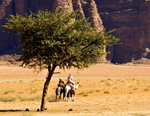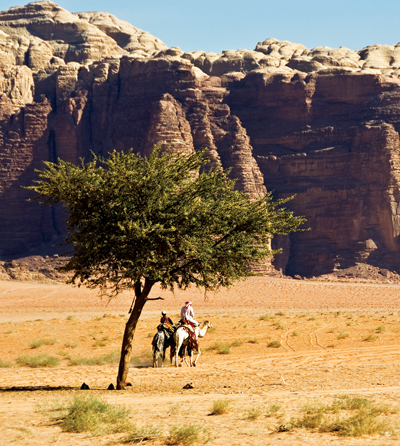The magic of Jordan
A trip to Jordan with a hidden city, a waterfall at shower temperature and the lowest point on the planet


Terribly chuffed to meet you, I'm sure,' announced Ahmed, our Bedouin guide. We were in Petra, walking down the narrow gully that is the Siq, while dodging the pony traps being driven at a rattling pace by other tribesmen (you have to be a native of Petra to work there). I looked after the one that contained my wife, wondering if it wouldn't have been worth risking her footwear on the ancient paving stones after all.
Ahmed has never been outside Jordan, but has a quick ear and a passion for satellite television. His eyes, underscored by a line of kohl, the traditional Bedouin cosmetic thought to protect against the sun's glare, glittered. ‘Lovely jubbly,' he said. Our knowledge of Ahmed's country had been, by contrast, somewhat limited before going there. ‘Jordan's outside the Holy Land,' observed our eight-year-old son Charlie, looking at a globe one breakfast time. It would not be safe for me to reveal which family member replied: ‘What's she doing there?'
But after a night at Wadhi Rum ‘rustic' is the rather euphemistic term that tour operators use to describe the conditions-we felt we could have looked T. E. Lawrence in the eye.
Dawn is the time to experience this landscape of parched, yet seemingly weeping rocks, their surface carved into filigree by sandstorms-and for once I had no difficulty in rising at that hour, given the Spartan comforts of the bed. We had what the boys called a Sea of Sand moment, recalling the 1958 film about the Desert Rats that, courtesy of a national newspaper, we had watched before coming out. Climbing the sand dunes, we kept an eye open in case a speck in the immensity of the valley was really one of the Afrika Corps's half-tracks, appearing from behind a round-shouldered mountain. Lawrence of Arabia was filmed here.
The drive back to our hotel at Ma'in Hot Springs, along the one road that might be considered a motorway in Jordan, was long and dusty. But this only served to heighten our enjoyment of the great natural phenomenon beside which the Evason is set. This is a waterfall, gushing in an unceasing, mineral-enriched cascade down a cliff face and into a river that helps feed the Dead Sea. King Herod slithered over the riverbed, as we did, to sit under it.

Or perhaps, if he had sensitive feet, he chose to be carried across: the river water is hotter than you would run a bath. Having begun its journey in the snowy mountains of Iran, it seeps through underground fissures until meeting the earth's magma in this formerly volcanic region. Superheated, it then bubbles up as springs. The water emerging at the top of the cliff loses temperature as it descends the waterfall; it's warm, not scalding, by the time it reaches your head and shoulders.
As part of the Six Senses group, the Evason is serious about ecology. You can trek along the wadhi before breakfast, or, less strenuously, enjoy the sunset over the Dead Sea, with the lights of Jerusalem twinkling in the distance, from a ‘panoramic complex' that includes an Arabic restaurant. There is a library for further reading. Do not imagine that the architecture is as beguiling as the same company's Zighy Bay in Oman: the hotel itself, built 30 years ago, has defied the best attempts to soften its rectangularity.
Exquisite houses, the beauty of Nature, and how to get the most from your life, straight to your inbox.
On the other hand, I can't remember a happier family meal than our private barbecue, served on the eighth-floor terrace overlooking the waterfall. The oxygen may have had something to do with it. At more than 820ft below sea level, Ma'in benefits from the reverse of the thinning atmosphere encountered by mountain-eers. Oxygen levels increase as you go down; they boost the system. You sleep well at night.
The Dead Sea itself is lower still; in fact, at 1,300ft below sea level, it is the lowest point on the planet (remember, if you're puzzled, the Dead Sea is really a large lake). We enjoyed it from the marble splendours of the Kempinski Ishtar, an architectural tribute to the Hanging Gardens of Babylon that would have appealed to Cecil B. de Mille.
There are no fewer than nine swimming pools. No visit is complete without smearing face and body with the black, volcanic mud from the bottom of the Dead Sea, which certainly has transforming properties, if not rejuvenating ones. (‘I can personally attest to its improving the sex drive,' claimed one of its advocates.) It's a measure of the place that the Kempinski mud, which guests scoop out of terracotta pots, has been processed and perfumed, to make it more acceptable to the nose; in its raw state, it's sulphurous. A bob in the Dead Sea will, thank goodness, wash it off. Jordan isn't a cheap destination, but it is, as yet, a relatively undiscovered one.
A quarter of an hour's drive from the Kempinski is the site of Christ's baptism in the River Jordan. It was from the top of Mount Nebo that Moses looked out and proclaimed the Promised Land. Madaba, a largely Christian town famous for its mosaics, contains a sixth-century map of the Holy Land in a mosaic floor.
The Roman remains at Jerash-colonnades, triumphal arch, nymphaeum, theatre are spectacular. Tourism isn't highly developed; if you're jostled, it will be by a camel. Besides, due to industry and irrigation, the level of the Dead Sea is falling by 3ft every year. This could be the time to go.
* For more holiday features like this every week, subscribe and save
Country Life is unlike any other magazine: the only glossy weekly on the newsstand and the only magazine that has been guest-edited by His Majesty The King not once, but twice. It is a celebration of modern rural life and all its diverse joys and pleasures — that was first published in Queen Victoria's Diamond Jubilee year. Our eclectic mixture of witty and informative content — from the most up-to-date property news and commentary and a coveted glimpse inside some of the UK's best houses and gardens, to gardening, the arts and interior design, written by experts in their field — still cannot be found in print or online, anywhere else.
